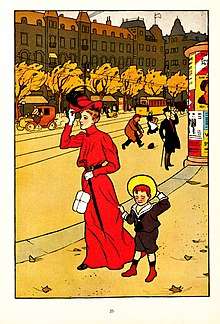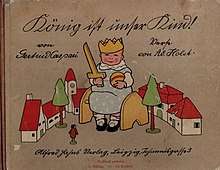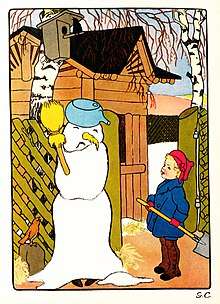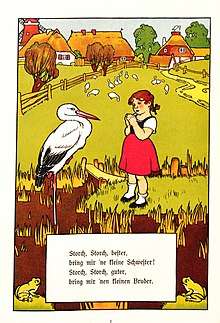Gertrud Caspari
Gertrud Caspari (March 22, 1873 in Chemnitz - June 7, 1948 in Klotzsche, Dresden) was one of the most important German children's book illustrators in the first half of the 20th century, and is recognised as the creator of a "modern toddler" or "Caspari" style.
Gertrud Caspari | |
|---|---|
Grave medallion of Gertrud Caspari | |
| Born | March 22, 1873 Chemnitz, Saxony |
| Died | June 7, 1948 (aged 75) Klotzsche, Dresden |
| Occupation | Children's book illustrator and writer |
| Nationality | German |
| Education | Dresden School of Applied Arts |
| Genre | Picture books |
| Notable works | Children's Land, You Magic Land In the Animal Nursery Our Child is King |
| Years active | 1903-1945 |
Early life and education
Gertrud Caspari was born in Chemnitz in 1873[1] as the fourth of five children of the merchant Robert Caspari.[2] After the death of her father in 1888, the family moved to Dresden in 1894.[2] Gertrud Caspari worked as a governess for a year,[1] and then studied at the Dresden School of Applied Arts from 1895 to 1898, training to be a teacher.[1][2][3] However, she fell seriously ill in 1897 from Graves' disease,[1][3] which kept her bedridden for many years.[2] It was during that time that she had the idea for a first illustrated children's book.
Career
Her first picture book appeared in 1903 under the title The Living Toy.[1][2][3] The following year, she successfully participated in the Arts and Crafts Exhibition in Leipzig, where she showed frieze designs in appliqué.[2] She regularly received orders to illustrate children's books, and also illustrated textbooks and songbooks.


In 1906, she and her brother Walther Caspari, who worked as a graphic designer for political magazines, were commissioned by the Leipzig teacher's association to create the picture book Kinderhumor für Auge und Ohr (Children's Humor for Eye and Ear).[1] The book was published in 1906 by Verlag Alfred Hahn in Leipzig and established a 40-year cooperation between the publisher and Gertrud Caspari. The author Adolf Holst wrote verses for many of the illustrations.
Her brother Walther died in 1913 at the age of 44, leaving Gertrud Caspari to carry on the work alone. The following year she moved from one part of Dresden, Bühlau, to another, Klotzsche,[1] where she lived until the end of the Second World War. During the time of Nazi Germany, she illustrated educational books for the Ministry of Propaganda. After the war, she was charged with collaboration. Caspari lost her apartment in Klotzsche and spent her last years in Lößnitz in the Erzgebirge,[1] where she lived in poverty.
Caspari published over 50 of her own children's books with illustrations, and illustrated more than 20 other works by other authors.[2] In addition, she designed postcards, games, calendars and even porcelain figures.[1][2][3] In 1927, she created murals and stained glass windows for a children's rest home in Jetřichovice (German: Dittersbach) in the district of Tetschen (now in the Czech Republic). Her illustrations of baby animals and their parents formed the basis of early arithmetic for many children in the 1920s.[4]
Caspari is considered the creator of a "modern toddler style", which is also referred to as "Caspari style".[1][3] "Her painting is characterized by large areas, often monochrome backgrounds, simple perspectives, sharp contours, simple figures and a bright-warm color."[1] She also drew scenes of her Saxon homeland.[2]
For Caspari, the format of the book and the thickness of the pages were important in terms of child-friendly handling and she chose materials accordingly. The estate and rights of her works are managed by the Gertrud Caspari Family Foundation. Some of the books have been reissued by the foundation.
Selected publications


Titles have been translated into English from the original German.
- The Living Toy (Das lebende Spielzeug) (1903) [1]
- The Summer Trip! (Die Sommerreise!) (1905)
- Children's Humor for Eye and Ear (Kinderhumor für Auge und Ohr) (1906) [1]
- Funny Book for Toddlers (Lustiges Kleinkinderbuch) (1907) [1]
- Children's Land, You Magic Land (Kinderland, du Zauberland) (1908) [1]
- Watch and Show Book (Anschauungs- und Darstellungsbuch) (1909)
- Spring, Spring Everywhere! (Frühling, Frühling überall!) (1910)
- Our Child is King (König ist unser Kind) (1910)
- For the Little Ones! (Für die Kleinen!) (1913)
- Caspari Primer (Caspari-Fibel) (1912)
- Seasons (Jahreszeiten) (4 parts, 1912-1915)
- What Is That, My Little Child?: a book for the little ones (Was ist das, mein Kindchen?: ein Buch für die Allerkleinsten) (1913)
- Big People (Große Leute) (1916)
- From My Sketchbook (Aus meinem Skizzenbuch) (1917)
- Look Here (Schau mal her) (1918)
- Good Morning (Guten Morgen) (1918)
- For the Little Ones (Für die lieben Kleinen) (1920)
- In the Animal Nursery (In der Tierkinderstube) (1925) [1]
- Just Come Inside! (Kommt nur herein!) (1925)
- A Very Merry Arithmetic (Eine ganz fidele Rechnerei) (1927)
- The Jolly 1 × 1 for our ABC Beginners (Das lustige 1 × 1 für unsere ABC-Schützen) (1929)
- Come Children! Sing! (Kommt Kinder! Singt!) (1934) [1]
- How Peter got his school satchel (Wie Peter zu seinem Schulranzen kam) (1935) [5]:171
- The children at "Waldhöhe" and other stories (Die Kinder auf "Waldhöhe" und andere Erzählungen) (1937) [5]
Death and legacy
Shortly before her death, she moved back to Dresden. Caspari died on June 7, 1948 in a hospital in Dresden of complications from a middle ear operation.[3] Her grave is located in the New Cemetery in Dresden-Klotzsche.
In 1954, a street in Klotzsche, Dresden was named after Gertrud Caspari. Her home on the Königsbrücker Landstraße 3 has been preserved. In 1998, a memorial plaque was placed on the house commemorating the well-known former resident. In addition, a primary school in the district bears the name Gertrud Caspari.
References
- Bochow, Fedor (11 June 2004). "Caspari Gertrud". Sächsische Biografie (in German). Institut für Sächsische Geschichte und Volkskunde e.V. Retrieved 21 August 2019.
- Stimmel, Folke (2005). "Zum Leben und Schaffen von Gertrud Caspari". In Druck Arbeitskreis Bild, Papier; Pieske, Christa (eds.). Arbeitskreis Bild Druck Papier, Volume 9 (in German). Waxmann Verlag. pp. 73–82. ISBN 9783830966562. Retrieved 20 August 2019.
- Oliveira, Elena de F. (28 April 2019). "Die „Bilderbuchtante" Gertrud Caspari". Dresdner Neueste Nachrichten (in German). Dresden, Germany. Retrieved 21 August 2019.
- Hepper, Eva (12 December 2018). "Schule, wie sie früher einmal war". Deutschlandfunk Kultur (in German). Retrieved 21 August 2019.
- Hopster, Norbert; Josting, Petra; Neuhaus, J (2017). Kinder- und Jugendliteratur 1933-1945: Ein Handbuch, Band 1: Bibliographischer Teil mit Registern (in German). Springer-Verlag. ISBN 9783476043832. Retrieved 21 August 2019.
Further reading
- Johannes Gebhardt. "Eine deutsche Kinder- und Märchenmalerin" ("A German child and fairy tale painter"). In: Reclams Universum: Moderne illustrierte Wochenschrift (Reclams Universe: Modern Illustrated Weekly) Vol. 40, No. 1, 1924, pp. 85-87.
- Hans Ries. Illustration und Illustratoren des Kinder- und Jugendbuchs im deutschsprachigen Raum 1871–1914. (Illustration and illustrators of the children's and youth book in the German-speaking area 1871-1914). Wenner, Osnabrück 1992, pp. 463-465. ISBN 3-87898-329-8
- Dieter Alfter. Kinderland, du Zauberland: Leben und Werk von Gertrud Caspari (1873–1948) (Children's Land, you Magic Land: Life and Work of Gertrud Caspari (1873-1948) ). Schloss Pyrmont Museum, Bad Pyrmont 1993.
- Wolfgang Neubert. Gertrud Caspari: Die Bibliographie der Bücher und anderer bildnerischer Arbeiten (Gertrud Caspari: The bibliography of books and other pictorial works). Burgart-Presse Henkel, Rudolstadt 1994, ISBN 3-910206-13-1